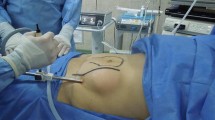Abstract
Purpose
Although changes in lateral abdominal wall musculature after posterior component separation with transversus abdominis release have been investigated, the effects of endoscopic subcutaneous anterior component separation (ES-ACS) on postoperative muscle anatomy have not been evaluated. The purpose of this study was to evaluate changes in the lateral abdominal muscles after ES-ACS.
Methods
Computed tomography (CT) images of patients who underwent ES-ACS were retrospectively evaluated. Lateral abdominal wall thickness and external oblique displacement were measured at the level of fixed retroperitoneal structures. Measurements on the ES-ACS side were compared with those on the contralateral undivided side or with preoperative images in patients with bilateral procedures.
Results
Fifteen patients met the criteria for study inclusion. Most patients (n = 13, 86.7%) underwent unilateral ES-ACS. The most commonly performed procedure was laparoscopic intraperitoneal onlay mesh-plus hernia repair (n = 12, 80.0%; the remaining patients underwent open repair). The Mean defect width was 8.4 cm (range 6–15 cm). There was no difference in the thickness of the lateral abdominal musculature between ES-ACS and undivided sides. There was a significant lateral displacement of the external oblique muscle from the lateral edge of the rectus abdominis on the ES-ACS side (mean distance 3.7 cm; p = 0.0006). No midline hernia recurrences, iatrogenic linea semilunaris hernias, or lateral eventrations were observed during a mean follow-up period of 2.6 years (range 0.5–7.4 years).
Conclusion
ES-ACS resulted in no atrophy of the lateral abdominal muscles in long-term CT follow-up. The procedure is a safe and effective adjunct to complex hernia repair in selected patients.


Similar content being viewed by others
References
Daes J, Telem D (2019) The principled approach to ventral hernia repair. Rev Colomb Cir 34:25–28
Pauli EM, Rosen MJ (2013) Open ventral hernia repair with component separation. Surg Clin North Am 93:1111–1133
Winder JS, Behar BJ, Juza RM, Potochny PEM (2016) Transversus abdominis release for abdominal wall reconstruction: early experience with a novel technique. J Am Coll Surg 223(2):271–278
Novitsky YW, Fayezizadeh M, Majumder A, Neupane R, Elliott HL, Orenstein SB (2016) Outcomes of posterior component separation with transversus abdominis muscle release and synthetic mesh sublay reinforcement. Ann Surg 264:226–232
Daes J (2014) Endoscopic subcutaneous approach to component separation. J Am Coll Surg 218:e1–e4
Daes J, Chen D (2017) Endoscopic components separation techniques. In: Hope W, Cobb W, Adrales G (eds) Textbook of hernia. Springer, Basel, pp 243–248
Ferretis M, Orchard P (2015) Minimally invasive component separation techniques in complex ventral abdominal hernia repair: a systematic review of the literature. Surg Laparosc Endosc Percutan Tech 25:100–105
Daes J, Dennis RJ (2016) Endoscopic subcutaneous separation as an adjunct to abdominal wall reconstruction. Surg Endosc 22:1–5
De Silva GS, Krpata DM, Hicks CW, Criss CN, Gao Y, Rosen MJ, Novitsky YW (2014) Comparative radiographic analysis of changes in the abdominal wall musculature morphology after open posterior component separation or bridging laparoscopic ventral hernia repair. J Am Coll Surg 218:353–357
Hicks CW, Krpata DM, Blatnik JA, Novitsky YW, Rosen MJ (2012) Long-term effect on donor sites after components separation: a radiographic analysis. Plast Reconstr Surg 2012(130):354–359
Daes J, Winder JS, Pauli EM (2020) Concomitant anterior and posterior component separations: absolutely contraindicated? Surg Innov. https://doi.org/10.1177/1553350620914195
den Hartog D, Eker HH, Tuinebreijer WE, Kleinrensink GJ, Stam HJ, Lange JF (2010) Isokinetic strength of the trunk flexor muscles after surgical repair for incisional hernia. Hernia 14:243–247
Acknowledgments
We thank Rebecca Tollefson, DVM, from Edanz Group (https://en-author-services.edanzgroup.com/) for editing a draft of this manuscript and Sabbagh Radiólogos for collaborating in the retrieval and analysis of CT images.
Author information
Authors and Affiliations
Corresponding author
Ethics declarations
Conflicts of interest
The author(s) declared no potential conflicts of interest with respect to the research, authorship, and/or publication of this article.
Ethical approval
IRB approval was waived due to the retrospective nature of the study.
Human and animal rights
The research did not involve human participants. Animals did not participate in the study. Only non-identifiable material was used in the present study.
Additional information
Publisher's Note
Springer Nature remains neutral with regard to jurisdictional claims in published maps and institutional affiliations.
Rights and permissions
About this article
Cite this article
Daes, J., Morrell, D. & Pauli, E.M. Changes in the lateral abdominal wall following endoscopic subcutaneous anterior component separation. Hernia 25, 85–90 (2021). https://doi.org/10.1007/s10029-020-02303-6
Received:
Accepted:
Published:
Issue Date:
DOI: https://doi.org/10.1007/s10029-020-02303-6




